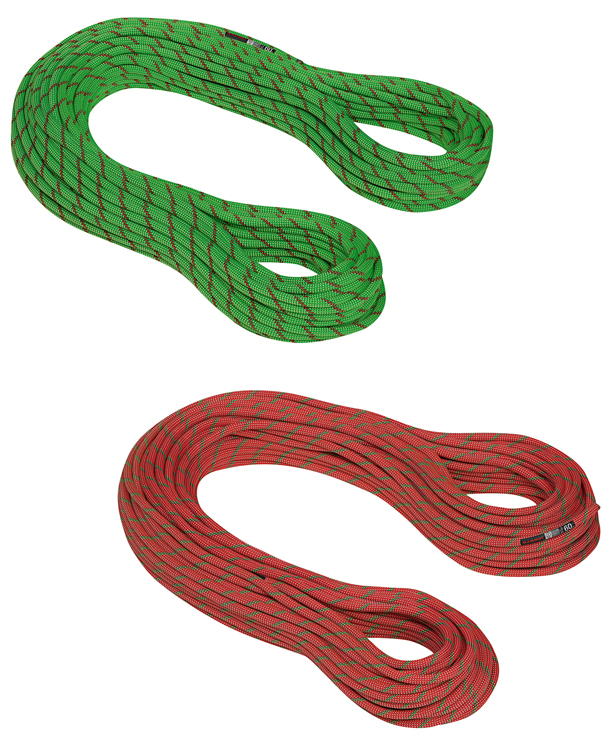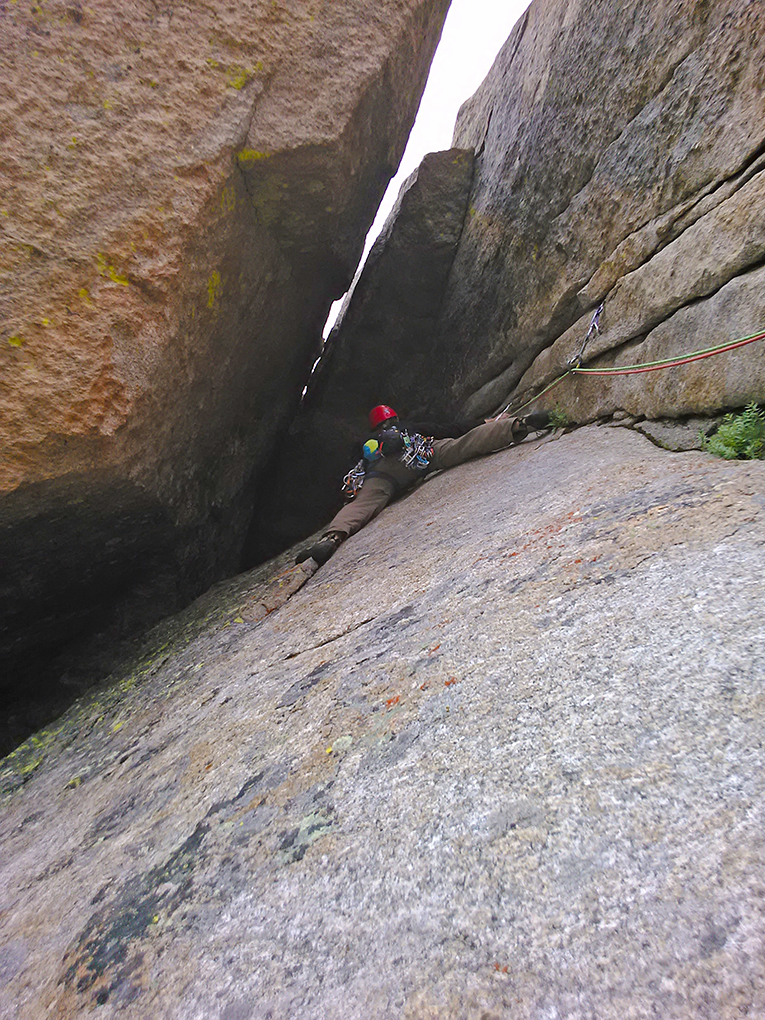
Mammut Twilight Twin Rope
Elongation at First Fall: 29%
Elongation with 80 kg: 8.5%
UIAA falls (2 strands 80 kg): 15-16
UIAA falls (2 strands 80 kg): 7-8
Sheat Slippage: 0mm
Impact Force in Kn: 6,2 / 9,9
Weight: 38 g/m
Days Tested: 10
Test Locations: Rocky Mountain National Park, Colorado
Modern twin ropes have undergone a significant transformation in the past few years, not only following the general trend toward lighter and thinner cords, but blurring the line between twin ropes and half ropes. And since this terminology is integral to the discussion, let’s do a brief tour through some fundamental rope jargon. (For those interested in a deeper discussion on this topic, stay tuned for an upcoming article on climbing ropes.)
Broadly, rope systems involving the simultaneous use of two dynamic ropes (besides arrangements such as a dynamic rope and a tag line, etc.) can be broken down into two major categories: half ropes and twin ropes.
Half Ropes vs. Twin Ropes
In the half rope universe, the leader is tied into two ropes and clips each rope into different pieces of protection. This can enable the climber to reduce rope drag over wandering pitches, etc. Because the half ropes are clipped into different pieces of gear, any falls are held by only one of the two half ropes (whichever is clipped into the top piece).
Conversely, twin ropes are both clipped into every piece of protection resulting in any falls being caught by both ropes. Because twins are both clipped to each piece, they don’t offer the same ability to mitigate rope drag as half ropes, but they are generally lighter than halves and still offer the capability of full-length rappels.
UIAA (Union Internationale des Associations d’Alpinisme) Standards
In general, every rope must pass a standardized robustness test in order for it to be certified for a specific mode of use (single, half, twin). Google the UIAA or any number of forum discussions if you want to delve into the physics involved, but for now, suffice it to say that there are three different tests, one for each of the three modes of use: single, half, twin.
There is some lively discussion about how relevant or arbitrary the UIAA tests are relative to real world use, but the idea (in the case of halves and twins, anyway) is to make sure that any rope certified as a half rope can survive use in a system where falls are caught by only of the two strands, while ensuring that ropes to be used as twins don’t register too high an impact force on the climber.
But wait a sec. If twin rope systems split the fall force between two ropes, can’t every rope be used as a twin? After all, if a rope is strong enough to catch a fall on its own, won’t two work just as well?
The short answer is, No, this really isn’t advisable. The reason is that many thicker ropes don’t have as much stretch as their leaner counterparts, and two such ropes may catch a fall too suddenly, potentially transmitting a dangerous amount impact force to the climber.

Half Rope vs. Twin Rope Certifications
Thus, ropes that are rated for use both as halves and twins need to be robust enough to be used as halves, but still have low enough impact force to be used as twins. This brings us back to blurring the lines between these categories.
Unlike in years past, the majority of modern ropes designed for double rope systems are rated for use as both halves and twins. In fact, the new, ultrathin Edelrid Flycatcher (at a frighteningly thin 6.9mm) is the only recent rope I can think of that is rated only as a twin rope.
The Mammut Twilight is a great example of this style of modern twin/half rope. At 7.5mm, it is firmly in territory that used to be reserved for twin-rope use, and I can tell you that despite knowing they’re rated to be used as halves, taking a whipper onto one 7.5mm rope is a tense experience.
Weight
Because of its slender profile, the Twilight checks in at 38g/m, which makes it one of the lightest options available—it’s slightly heavier than the aforementioned Flycatcher (at 35g/m), and slightly lighter than the Sterling Fusion Photon (42g/m).
Traditionally, half ropes occupied the 8.2-8.8mm range, and many options still exist in this category. Depending on the exact diameter, the proportion of sheath vs. core material, and the weave, these medium diameter ropes tend to sit in the 43-48g/m range.
Now that cutting-edge twin ropes like the Twilight offer appreciable bulk and weight savings relative to beefier options like the Sterling Duetto, can we continue to justify choosing a heavier, 8.xmm half? Yes. Because double-rope systems are used by different climbers for many different things.
Toward the top of a long pitch, you’re not carrying just the weight of the rope, but also the drag generated as the rope threads through the series of clips below. Because of this, the weight of a rope in grams-per-meter only tells part of the story—a thinner diameter also reduces the contact area between rope and carabiner, resulting in less cumulative drag. Thus, you would expect a 7.7mm rope to generate less rope drag than an 8mm rope, even if they weigh the same. This, then, is the real benefit of the Twilight: it is lightweight and extremely thin. If you’re going to use the Twilight frequently as twins, then it is just about as good as your options get.
The Edelrid Flycatcher, by contrast, is slightly lighter and appreciably thinner, but you don’t have the option of leading on one of the lines, or using them as halves. Or at least in doing so you would be squarely outside the manufacturers specifications for the ropes. Not recommended.
Similarly, using a single rope with a tag line enables full-length rappels, but you’re left with a thin static cord if you get your lead line stuck. Thus, using the Twilights as your rope system incurs some weight penalty (and bulk penalty, if you’re packing them in or out) relative to ultrathin twins such as a Flycatcher, or a thin single with a tag line, but that penalty buys you the ability to climb on one of the strands should you need to retrieve a stuck rope.
This is a key tradeoff that anyone thinking about thin ropes should consider. It’s largely a matter of personal preference, and comes down to exactly how fast and how light you want to go in the alpine, as well as how comfortable you are dealing with a situation such as a rope getting stuck on rappel (and how likely that is to occur in the first place, given your objectives).
Mammut Twilight vs. Heavier Half/Twin Ropes
Alternatively, heavier, 8mm+ half/twin rope options like the Sterling Duetto, Edelweiss Oxygen, Beal Ice Line, etc., will bring more heft with them (these check in between 42- 45g/m) and thus aren’t compelling options for climbers looking primarily for twin rope use.
If, however, you’re looking to use your doubles in a half rope configuration (alternating which rope is clipped), then the ropes in the 8-8.5mm range do offer improved durability. In half-rope mode, only one strand catches a potential fall, which can isolate some wear and tear onto one strand, potentially wearing the ropes quicker.
